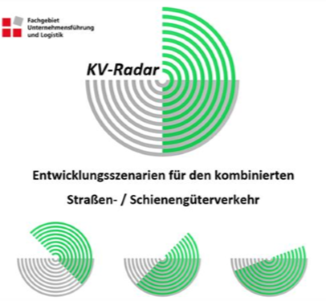Road freight transport regularly attracts attention through technical and organisational innovations. Examples such as platooning, catenary trucks or future visions of autonomous driving increase the attractiveness of road transport and seem to give it essential characteristics of rail transport. Increasing digitalisation of order processing (e.g. by establishing digital forwarding agents) is making the processing of transport orders increasingly easier and is also increasing the attractiveness of road freight transport. However, road freight transport has a negative impact on the environment and society due to its high external burdens and costs. In particular, the heavy use of infrastructure and the high consumption of resources are increasingly critical in this respect.
In contrast to road freight transport, combined transport (e.g. road-rail or road-inland waterway transport) is considered to be more environmentally friendly and infrastructure-friendly. The shift of freight transport to rail infrastructure, which is considered in the present project, can help to achieve environmental and social goals due to the suitability of rail for heavy goods transport. However, the inherent multi-linked transport chain of combined transport causes disadvantages in the areas of organisation and flexibility, which uninterrupted direct road freight transport does not have. In particular, the demand of modern logistics for flexibility and speed additionally promotes the use of road freight transport compared to combined transport.

The present project aims to strengthen combined transport in Germany and especially in the transit state of Hesse. Within the framework of a Delphi study, experts will be identified and their opinions and recommendations for strengthening combined transport will be queried and consolidated. A Delphi study is an instrument for reaching a consensus among experts in a multi-stage process. A “CT radar” is to be derived from the Delphi study, which will present different development scenarios for combined transport. In order to put the Delphi study on a solid basis, initial interviews with experts in combined transport will be conducted. The “CT Radar” forms the basis for a scientifically profound analysis of technological and organisational aspects of combined transport and for the development of specific fields of action and recommendations.
In order to present the results to the public in an appropriate manner, the “Combined Transport Forum” at HOLM Frankfurt will be used as the final event of the project, which took place for the first time on 13.09.19 and will be continued on an annual basis. In this format, experts from science and industry, decision-makers in intermodal transport chains (shippers, forwarders, CT operators, rail transport companies, etc.), as well as politicians and society at large will have the opportunity to discuss specific measures to strengthen combined transport within the framework of the “CT Radar”. In particular, the location development of the transit state of Hesse is to be the focus of attention and should be discussed in depth by including CT in existing logistics concepts (e.g. for supplying cities) and logistics infrastructures (e.g. by linking it to the trans-eurasian corridor near Bebra).
Key Data:
Duration: May 2020 to April 2021
Sponsor: This project (HA project no..: 856/20-13) was funded by the State of Hessen and HOLM as part of the measure “Innovations in Logistics and Mobility” of the Hessian Ministry of Economics, Energy, Transport and Housing.
Project lead: Michael Gleser



